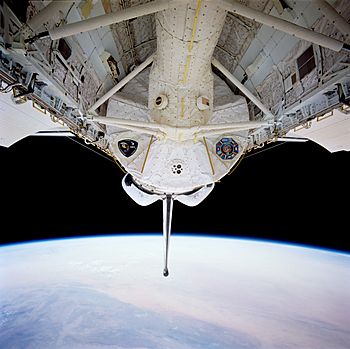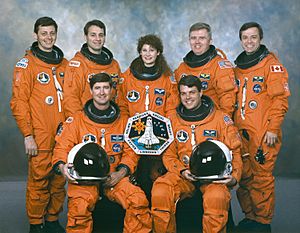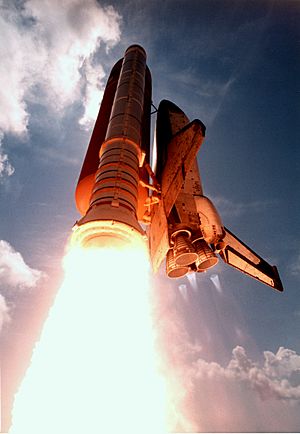STS-78 facts for kids

Spacelab Module LM2 in Columbia's payload bay, serving as the Life and Microgravity Spacelab
|
|
| Mission type | Bioscience research Microgravity research |
|---|---|
| Operator | NASA |
| Mission duration | 16 days, 21 hours, 48 minutes, 30 seconds |
| Distance travelled | 11,000,000 kilometres (6,800,000 mi) |
| Orbits completed | 271 |
| Spacecraft properties | |
| Spacecraft | Space Shuttle Columbia |
| Payload mass | 9,649 kilograms (21,272 lb) |
| Crew | |
| Crew size | 7 |
| Members |
|
| Start of mission | |
| Launch date | 20 June 1996, 14:49:00.0075 UTC |
| Launch site | Kennedy LC-39B |
| End of mission | |
| Landing date | 7 July 1996, 12:37:30 UTC |
| Landing site | Kennedy SLF Runway 33 |
| Orbital parameters | |
| Reference system | Geocentric |
| Regime | Low Earth |
| Perigee | 246 kilometres (153 mi) |
| Apogee | 261 kilometres (162 mi) |
| Inclination | 39.0 degrees |
| Period | 89.6 minutes |
  Left to right – Seated: Henricks, Kregel; Standing, Favier Linneham, Helms, Brady, Thirsk |
|
STS-78 was an important space mission that helped prepare for the International Space Station (ISS). It was the fifth time a special laboratory called Spacelab was used for life and microgravity research. The mission used the Space Shuttle Columbia, which launched from Kennedy Space Center's Launch Pad 39B on June 20, 1996. This flight was the 78th for the Space Shuttle program and the 20th for Columbia.
Contents
Meet the STS-78 Crew
The STS-78 mission had a crew of seven astronauts. They worked together to perform many science experiments in space.
| Position | Astronaut | |
|---|---|---|
| Commander | Fourth and last spaceflight |
|
| Pilot | Second spaceflight |
|
| Mission Specialist 1 | First spaceflight |
|
| Mission Specialist 2 | Third spaceflight |
|
| Mission Specialist 3 | Only spaceflight |
|
| Payload Specialist 1 | Only spaceflight |
|
| Payload Specialist 2 | First spaceflight |
|
Who Were the Backup Crew?
Sometimes, astronauts are chosen as backups in case a main crew member cannot fly. Here were the backup specialists for STS-78:
| Position | Astronaut | |
|---|---|---|
| Payload Specialist 1 | First spaceflight |
|
| Payload Specialist 2 | First spaceflight |
|
What Were the Mission Goals?
The main goals for the STS-78 mission were:
- To study how long spaceflights affect the human body. This research was very important for future missions to the International Space Station.
- To conduct 22 science experiments. These experiments focused on life science and how things behave in microgravity. They used the Spacelab module inside the Shuttle.
- To test a way to raise the altitude of orbiting satellites. This was done by carefully using the Shuttle's small thrusters.
Mission Highlights and Discoveries
The STS-78 mission lasted for 16 days and almost 22 hours. During this time, the crew of Columbia did a lot of work. They helped prepare for the International Space Station by studying how long trips in space affect people. They also did experiments similar to those now done on the ISS.
After launch, Columbia flew at an altitude of about 278 kilometers (173 miles). The orbit was tilted 39 degrees to Earth's equator. This special orbit helped the crew keep their normal sleep schedules. It also reduced vibrations that could mess up the microgravity experiments.
Once in orbit, the crew went into the 13-meter (40-foot) long Spacelab module. Here, they started over 40 science experiments. Some experiments used the Spacelab's lab area. Others used storage lockers in the Shuttle's middle section.
Experiments in Space
- Studying the Human Body: Thirteen experiments looked at how microgravity affects the human body. This included research on bone and muscle loss in space.
- Fluid and Material Science: Six experiments studied how liquids and metals act in near-weightless conditions. They also worked on making new metal alloys and growing protein crystals.
- Sleep in Space: The crew did the first full study of sleep patterns in microgravity. This helped scientists understand how space affects sleep.
- Fixing Equipment: Astronauts even fixed some equipment in space. They repaired the Bubble, Drop and Particle Unit (BDPU). This device was used to study how fluids behave.
Boosting Satellites with Thrusters
The mission also tested a new way to raise the altitude of satellites. This method was later used for the second Hubble Space Telescope servicing mission. During the test, Columbia's small thrusters, called vernier Reaction Control System jets, were gently pulsed. This slowly boosted the Shuttle's altitude without shaking the experiments. The test worked well! This method was later used by Discovery during STS-82. It has also been used many times to boost the orbit of the ISS when Shuttles visited.
Important Findings After the Mission
After the mission, engineers found some unexpected damage on the Shuttle's solid rocket boosters (SRBs). Hot gases had caused damage to the booster's field joints. This kind of damage was similar to what caused the Challenger accident.
Even though there was no danger to the astronauts on STS-78, this finding was very serious. It raised questions about a new cleaning fluid being used. Because of this issue, the next mission, STS-79, was delayed. STS-79 was supposed to dock with the Space Station Mir and bring astronaut Shannon Lucid back to Earth. Luckily, the Shuttle was found safe to fly, and Shannon was returned as planned.


